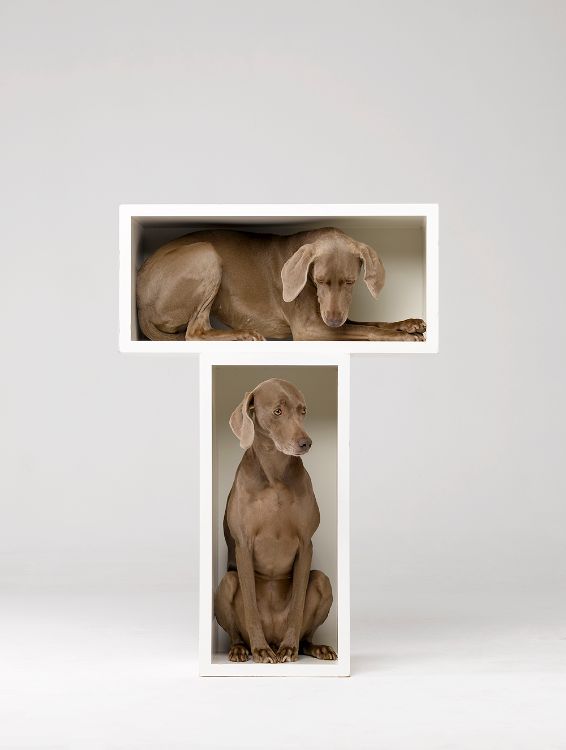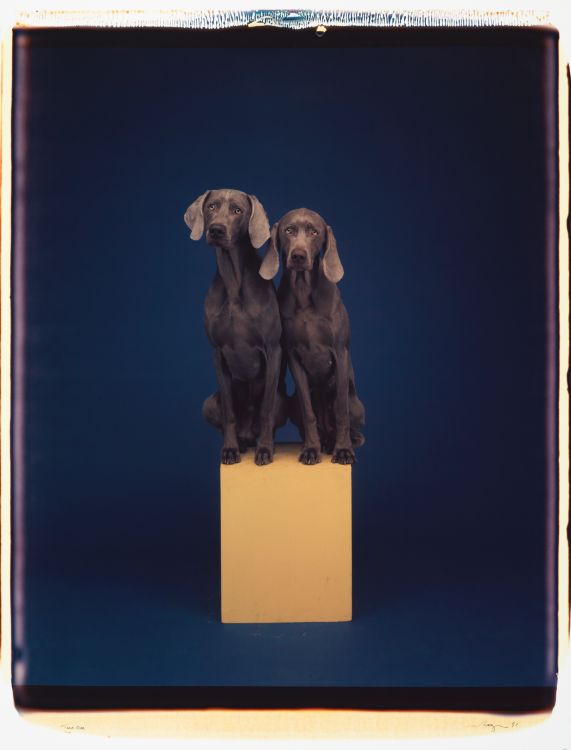In 1978, William Wegman was invited to The Polaroid Corporation’s headquarters in Cambridge, Massachusetts to work with their newly developed 20×24 inch Polaroid camera, made to promote its new Polcolour II film. The camera weighed an enormous 107kg, and contained within it a roll of modern instant film that produced richly coloured, large-format photographs.
Although the new format was a radical departure from previous work, which had been resolutely black and white, and printed no larger than 11×14 inches, Wegman was instantly drawn to the device. As he has since stated, with a Polaroid image there can be ‘no revision, no cropping.’ The camera’s simplicity, as well as its immediacy, appealed to the artist’s conceptual and counter-culture inclinations. The resulting series of images, made over the course of 28 years, are in turn outrageously funny, ironic or surreal, but also often full of poetry and poignancy. The works take as their subject Wegman’s lifelong muses; a long lineage of Weimaraners who have been by his side as pets, studio companions and artistic collaborators since 1970.
Wegman bought his first Weimaraner when, aged 26, he relocated from Wisconsin to Southern California, where he had taken up a teaching post at California Stage College, Long Beach. He named the dog Man Ray, after the famous Surrealist. At this time, Wegman’s conceptual-based art practice was performance orientated. He embraced video and photography particularly for their non-artistic, lo-fi potential, and his work used the two mediums to comment on contemporary culture and society. Wegman’s pioneering video pieces were particularly concerned with humour and self-awareness – often lampooning the pretentions of the same conceptual art that he himself was making. Man Ray began appearing in these video works almost immediately and the dog and the artist developed a deeply collaborative creative relationship.

Split Level, 2010
Wegman’s very first pictures made with the large-format Polaroid camera in 1978 were of Man Ray. Titled Fey Ray, one of the images captured the dark grey dog against a black background; with the subtlest accent of colour found in the bright red nail varnish that sparkles on the dog’s claws and in the small bottle of nail varnish placed next to him. Beginning with the bottle of nail varnish,Wegman’s subsequent Polaroid pieces brilliantly and serendipitously hang off a single idea, a prop, or a dog’s particular characteristic.
After Man Ray’s death in 1982, Wegman did not return to photographing dogs with the Polaroid camera until 1987. Fay Ray, a second Weimaraner, became Wegman’s new collaborator and muse, and the two worked extensively together to perfect their aesthetic. The carefully staged works encompass performance, wit and compositional formalism. These images employ monochromic backgrounds in luminous primary colours, against which the figure of the dog is used as an almost abstract element. Sometimes, the dog is only a singular part of a larger composition that features plinths, pedestals or other more complicated shapes that the dog balances on top of or curls gracefully up inside of. The shallow depth of field of the large-format Polaroid required the placing of the subject carefully into the shallow space, and Wegman revelled in finding an aesthetic that compliments the restrictions inherent in this format. With Fay, Wegman began to utilise colour, shape and line, and to take visual cues from the history of art, placing Fay in the centre of it all. Wegman’s references to Surrealism, Cubism and colour theory gently subvert the conventions of art history and art practice. Much the same as the earlier video piece Milk/Floor, it is the figure of the dog that disrupts any singularly formal reading of the work, underlining Wegman’s wit and subversive sensibility.
With Fay Ray’s litter in 1989, Wegman discovered a new cast of characters and her puppies Chundo, Crooky and Battina became vital players in the company. Now multiple dogs became multiple forms with which to bend and shape, and narratives begin to emerge within the works. It was at this time that Wegman began to place Fay Ray up on a pedestal, filling the full frame in anthropomorphic verticality. She was draped in cloth in early variations, but later wore long gowns or other fantastical costumes. These images would develop into a number of hybrid human-animal characters, with human hands gesturing from dog’s bodies. In these surreal portraits, Fay Ray and the other dogs take on many roles, donning a plethora of costumes, in order to examine (and satirise) ideas of identity and culture. Fay is demure and graceful in My Coo Kie (with the added bonus of having biscuits for hands), and poses delicately in a chic gown in Dressed from Below. In Towelling, however, in a peach towelled dressing gown, she is transformed once more, and is suffused with a sense of suburban pathos.
As Wegman has said, ‘that is how we are wired, to see ourselves’. The dogs, bewigged and bedecked with outfits and props, demonstrate a wide range of human personas. These works begin to unpick and explore the tensions between façade and identity. In the Polaroids, Wegman enlists clichés and coded objects to call attention to this fact. Wegman utilises the dogs, in their varying degrees of embellishment and whimsy, to demonstrate how identity is often something that is imposed from the outside.
Wegman used the large-format Polaroid camera to reimagine the familiar as the fantastical, transforming dogs into abstracted forms, ideas and imagined characters. As witty and shrewdly insightful as many of these works are, they remain sumptuous to behold, with masterful staging and rich, jewel-like colours. Wegman and his troupe of dogs manage all of this contemplation and complication with an unwavering whimsical attitude and sense of humour
(By Thea Gregory)
